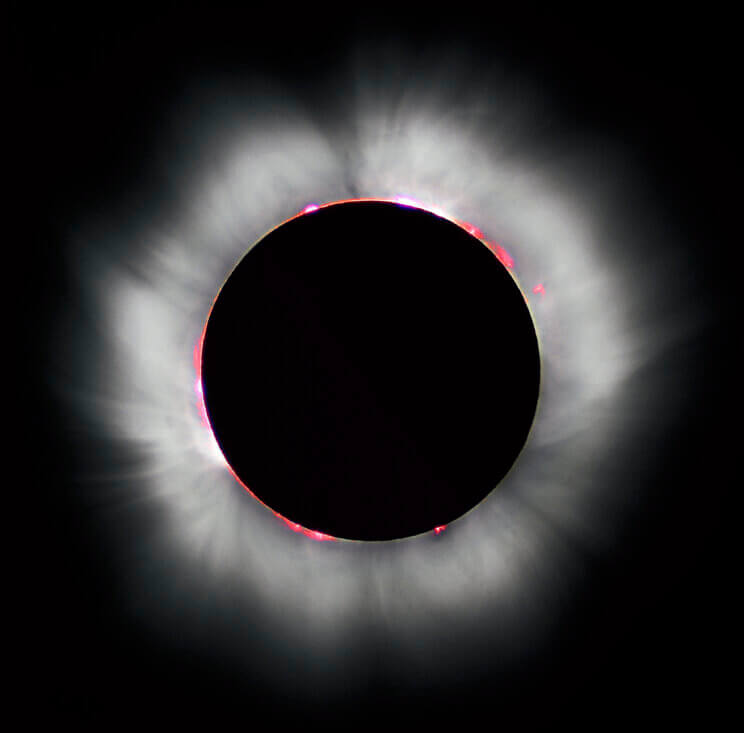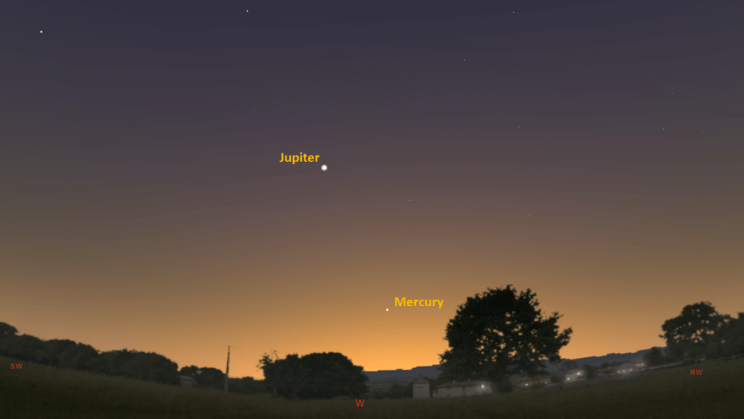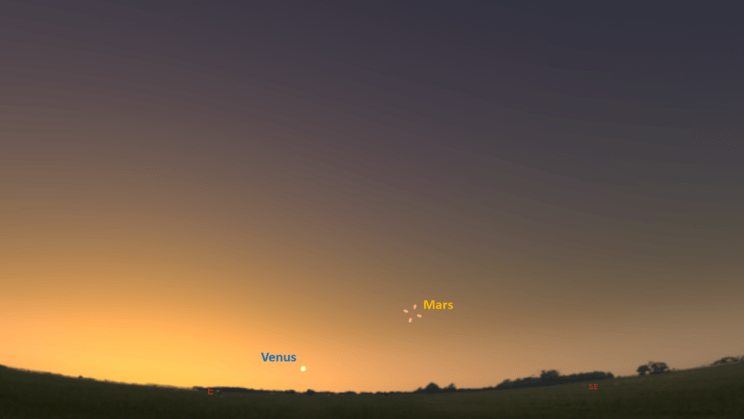This is the Saint Louis Science Center’s NIGHT SKY UPDATE for the week of Saturday, March 16, 2024.
Information updated weekly or as needed.
Times given as local St. Louis time this week will be in Central Daylight Time (CDT). For definitions of terminology used in the night sky update, click the highlighted text. If relying on times posted in Universal Time (UT), St. louis is -5 hours when CDT.
Join us for our next star party, Friday, April 5, 2024, held in association with the St. Louis Astronomical Society. For details, see the information at the bottom of this page or visit https://www.slsc.org/explore/mcdonnell-planetarium/public-telescope-viewings/
Observing Highlight of the Week

Total solar eclipse seen from from France on August 11, 1999. The white crown like structure around the Sun is called the solar corona. The pinkish red structures seen near the limb of the Sun are in the Sun’s chromosphere. Image credit: Luc Viatour.
Now just weeks away, the total solar eclipse occurring on April 8, 2024, is an event worth traveling for. I encourage all who can travel that day to go to where totality is visible because what is visible during totality is unlike any other experience. In ancient times, solar eclipses were often feared. They were once an event that disturbed the cosmic balance people associated with the sky. In time we would understand what they were and how we could predict their occurrence eliminating their mystery.
While they no longer are events that disrupt our existence, they still have the means to amaze and emotionally impact the viewer. Because of this, I would like to explore this week what you can see if you travel to the path of totality.
A total solar eclipse occurs when the Moon passes in front of the Sun completely obscuring the bright solar disk. The entire eclipse on April 8 will last about 2.5 hours while totality will only last a few minutes. The length of totality is dependent on how deep into the path you travel. If you travel to the center line in the path, totality can last about 4 minutes. If you are just inside the edges of the path, it will only be a few seconds. It is imperative to know exactly when totality starts and ends because it is the one time you can look towards the Sun without eclipse glasses. There are several interactive eclipse maps available online that calculate the times you need. The one I use is created by Xavier Jubier. Be aware that the times found using this map will be in Universal Time. You will need to calculate what those times are for your local time zone. You can find this interactive map at http://xjubier.free.fr/en/site_pages/solar_eclipses/TSE_2024_GoogleMapFull.html
As we approach totality, the first thing you will notice is how color perception changes in the world around you. While the Moon is slowly moving in front of the Sun, the world around you begins to dim. Minutes before totality, with most of the Sun covered, you will notice your perception of color subtly changes. The world takes on a greyish sepia tone appearance. As our eyes begin to adapt to the growing darkness, our color perception will shift to a peak sensitivity of blue-green wavelengths due to an increase in rod activation and a decrease in cone activation. This adjustment period is called mesopic vision. While the shift occurs your peak light sensitivities will see a shift away from the red end of the spectrum towards the blue end. This effect is called the Purkinje Effect. The appearance of red and green objects will show this shift the best. Red will appear dimmer while green will appear brighter.
Once the Moon is completely in front of the Sun, totality begins. With the blinding disk of the Sun obscured, it is dark enough for us to see the Sun’s outer atmosphere called the solar corona. It appears as a dim white crown surrounding the Sun. In the corona you will notice elongated cusp-like structures called coronal loops. These are closed magnetic loops that are stretched out to a point by the solar wind. If near solar minimum they appear nearer the Sun’s equator. This year we are nearing solar maximum so the coronal streamers should appear to be more symmetrically distributed. For observers on Earth, the solar corona is only visible during a total solar eclipse. Today space agencies have space based solar telescopes with cameras equipped with coronagraphs which block the solar disk like the Moon does during an eclipse allowing astronomers to study the solar corona.
The Sun’s chromosphere is also visible during totality. The chromosphere is the inner portion of the Sun’s atmosphere. If features are visible, they will be seen near the limb of the Sun. It appears pinkish red in color due to the excitation of hydrogen atoms. How much of it is visible depends on what solar activity is occurring. If there are any large prominence present, they will appear as large bright structures extending from the Sun. The chromosphere can be seen on any clear day thanks to a special narrow band solar filter that targets the H-alpha frequency of light. These telescopes are available on the amateur market by they are expensive.
What is seen during totality is truly amazing. While the corona is the main draw, the temporary twilight we encounter also allows us to briefly see a few other objects. The planets Jupiter and Venus should be easy to spot. Jupiter will be the bright starlike object 28° east of the Sun while Venus will appear roughly 13° west of the Sun. A little further west are the planets Saturn and Mars. They are roughly 35° west of the Sun but will be much dimmer. Unfortunately, they could be too dim to spot naked eye. The other target many are excited for is the comet 12P/Pons-Brooks. The comet will appear about 6° west of Jupiter. It should be visible through binoculars but take extreme caution if you intend to look for the comet. You do not want to accidentally look towards the Sun as totality ends.
There are also other senses that might notice a change during totality. Visually the world will look darker. You may also hear animal sounds you are accustomed to hearing as night approaches. Birds will likely sing their twilight songs, joined by the orchestral drone of crickets and cicadas. In Missouri, we will experience the emergence of the cicada brood known as Brood 19. You may notice a large increase in cicada activity during the eclipse. Wind direction can change as will the temperature. There will be lots of stuff to experience during totality.
Hopefully everyone reading this post will get the chance to see totality on April 8. If you cannot travel to see it or perhaps weather spoils the opportunity, there are other eclipses visible in future years. 2033 and 2044 will have total solar eclipses visible from limited areas in North America. In 2033 you will have to travel to western and northern reaches of Alaska to see it. In 2044, you will have to travel to portions of Montana and North Dakota to see totality. The next best option for many of us will be in 2045 when another total solar eclipse will be visible from southern portions of the United States. Or you could travel the world tracking down total solar eclipses from different counties.
Comet 12P/Pons-Brooks Update
For those interested in observing periodic comet 12P/Pons-Brooks, it can still be found in the west by 8:00 p.m. Currently, the comet is found in the constellation Pisces with magnitude estimates between 5.5 and 5.8. At this magnitude urban viewers will still need to use a telescope to spot the comet. If you are in darker skies, this magnitude should be bright enough to see in binoculars. Last week I was able to spot the comet using 8×56, 10×50 and 8×28 binoculars from suburban skies. As we approach the comet’s perihelion on April 21, 2024, it should continue to brighten. We will update this section as new information arises.
The Sun and Moon

The Moon as seen from the International Space Station, on July 31, 2011.
Credit: NASA
Sun
Sunrise is at 7:09 a.m. on Saturday, March 16 and sunset is at 7:09 p.m. providing 12 hours of daylight this week. By the end of the week, it will be around 12 hours and 20 minutes of daylight. Even after sunset, light from the Sun will dimly illuminate our sky for about 1 hour and 30 minutes. This period is called twilight, which ends around 8:40 p.m. this week. For those with a sundial, local noon occurs around 1:09 p.m. on March 17, 2024.
| Day | Sunrise | Sunset | ||||||||||
|---|---|---|---|---|---|---|---|---|---|---|---|---|
| 16-Mar | 7:09 a.m. | 7:09 p.m. | ||||||||||
| 17-Mar | 7:08 a.m. | 7:10 p.m. | ||||||||||
| 18-Mar | 7:06 a.m. | 7:11 p.m. | ||||||||||
| 19-Mar | 7:05 a.m. | 7:12 p.m. | ||||||||||
| 20-Mar | 7:03 a.m. | 7:13 p.m. | ||||||||||
| 21-Mar | 7:02 a.m. | 7:14 p.m. | ||||||||||
| 22-Mar | 7:00 a.m. | 7:15 p.m. | ||||||||||
| 23-Mar | 6:59 a.m. | 7:16 p.m. | ||||||||||
| 24-Mar | 6:57 a.m. | 7:17 p.m. |
Moon
Moonrise for Saturday, March 16 was at 11:0 a.m. and moonset occurred at 2:57 a.m. on the following day. On Saturday, March 16, the Moon will exhibit a waxing crescent phase with roughly 1% disk illumination. By the end of the week the Moon will be near its full phase. First quarter moon occurs on March 17, 2024, at 9:24 a.m. Full moon for March occurs on March 25, 2024, at 2:00 a.m.
There is a shallow penumbral eclipse occurring on March 24/25, 2024. While it is visible from St. Louis, the Moon will barely be passing into Earth’s penumbral shadow. For visual observers, no change in the lunar appearance is expected.
International Space Station (ISS) Observing

There are several visible passes of ISS from St. Louis for the week of March 9. They occur during evening hours. The table below lists the best of these passes that will be seen from St. Louis. If you do not live in the area, you can use https://heavens-above.com/ to set your viewing location and get times for where you are.
Catch ISS from St. Louis starting Saturday, March 16, 2024
| Date | Starts | Max. altitude | Ends | |||||||
|---|---|---|---|---|---|---|---|---|---|---|
| Time | Alt. | Az. | Time | Alt. | Az. | Time | Alt. | Az. | ||
| 18 Mar | -1.4 | 19:56:35 | 10 | WNW | 19:59:11 | 20 | NNW | 20:01:46 | 10 | NNE |
| 24 Mar | -0.8 | 21:40:52 | 10 | NNW | 21:41:35 | 14 | NNW | 21:41:35 | 14 | NNW |
Magnitude (Mag): The Measure of brightness for a celestial object. The lower the value is, the brighter the object will be.
Altitude (Alt): The angle of a celestial object measured upwards from the observer’s horizon.
Azimuth (Az): The direction of a celestial object, measured clockwise from an observer’s location with north being 0°, east being 90°, south being 180° and west being 270°.
Detailed information regarding all unmanned exploration of our universe, missions past, present, and planned, can be found at Jet Propulsion Laboratories:
The Visible Planets

Looking west at 8:00 p.m. on March 17, 2024. Credit: Stellarium, EG

Looking southeast at 6:37 a.m. on March 18, 2024. Credit: Stellarium, EG
This week, two naked eye planets are easily seen. Jupiter is visible in the west once it is dark. Mercury will be visible low in the west 30 minutes after sunset. Venus will be lost to most while Mars is in the southeast before sunrise but twilight will be an issue.
Mercury
Mercury will be visible in the west about 30 minutes after sunset. Look for the elusive planet about 9° above the western horizon. Mercury reaches greatest eastern elongation on March 24, 2024. After this date It will quickly head back towards the glare of the Sun. Mercury reaches inferior conjunction on April 11, 2024.
Venus
Venus rises this week around 6:27 a.m. Venus is becoming increasingly difficult to spot due to its low altitude. Venus is approaching superior conjunction on June 4, 2024. Each day we get closer to this date, Venus will appear nearer the Sun. This week Venus will be too low for most of us to find it.
Mars
Over the last month, Mars has slowly begun to climb out of the Sun’s glare. For most, the red planet will still be difficult to find. Around 6:40 a.m., Mars is found about 9.5° above the southeastern horizon. The twilight glare will still be an issue.
Jupiter
Jupiter is now the only planet easily seen during evening hours. You can find Jupiter about 30 minutes after sunset, in the western sky. Jupiter sets around 10:55 p.m. this week. Jupiter’s current apparition is coming to an end as it heads towards superior conjunction on May 18, 2024.
Our next Star Party will be held on Friday, April 5, 2024, from dusk until 9 p.m.
As part of the Saint Louis Science Center’s First Fridays, weather permitting, the St. Louis Astronomical Society and the Science Center will set up a number of telescopes outdoors and be on-hand to answer your questions. Telescope viewing begins once it is dark. Regardless of the weather on April 5, join us indoors in our planetarium theater for “The Sky Tonight”. Showtime is at 7 p.m. This free, indoor star program will introduce you to the current night sky. Doors open 15 minutes before show time. Shows begins at 7 p.m. Sorry, no late admissions due to safety issues in the darkened theater.
The St. Louis Astronomical Society helps host the monthly Star Parties at the Saint Louis Science Center which are held on the first Friday of each month. Our Monthly Star Parties are open to the public and free of charge.
James S. McDonnell Planetarium
Night Sky Update: March 16-24, 2024






